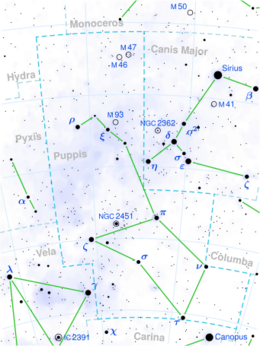Astronomy:3 Puppis
Script error: No such module "About-distinguish".
| Observation data Equinox J2000.0]] (ICRS) | |
|---|---|
| Constellation | Puppis |
| Right ascension | 07h 43m 48.46872s[1] |
| Declination | −28° 57′ 17.3720″[1] |
| Apparent magnitude (V) | 3.93[2] |
| Characteristics | |
| Spectral type | A2.7Ib[2] (A2Ia - A3IIpe[3]) |
| Apparent magnitude (K) | 2.340[4] |
| U−B color index | −0.09[5] |
| B−V color index | +0.18[5] |
| Astrometry | |
| Radial velocity (Rv) | 20.90±0.4[6] km/s |
| Proper motion (μ) | RA: -5.09±0.11[1] mas/yr Dec.: 3.90±0.15[1] mas/yr |
| Parallax (π) | 0.59 ± 0.17[1] mas |
| Distance | 1,700[4] pc |
| Absolute magnitude (MV) | −5.5[2] |
| Details[4] | |
| Mass | 31-39 M☉ |
| Radius | 55[3] R☉ |
| Luminosity | 63,000 - 160,000 L☉ |
| Surface gravity (log g) | 2.0[3] cgs |
| Temperature | 8,500 - 9,500 K |
| Other designations | |
| Database references | |
| SIMBAD | data |
3 Puppis (3 Pup) is a supergiant star in the constellation Puppis. It is a very rare A[e] supergiant, referred to as a B[e] star despite its spectral classification, and its apparent magnitude is 3.93.
3 Puppis is surrounded by a disc of circumstellar dust, which is unusual for an A-type star. It is thought to be caused by a low mass companion. The companion is calculated to be a B8III - B6V star with a mass of 5 M☉, and its orbit has a semi major axis of 2.3 AU. Like most B[e] stars, 3 Pup rotates rapidly, at 30% - 60% of the speed at which it would start to break apart. The disc has its inner edge only 3.8 AU from the primary star and it is suspected that deceleration of the hot primary stellar wind by the companion allows the dust to form unusually close to such a luminous star.[3]
References
- ↑ 1.0 1.1 1.2 1.3 1.4 Van Leeuwen, F. (2007). "Validation of the new Hipparcos reduction". Astronomy and Astrophysics 474 (2): 653–664. doi:10.1051/0004-6361:20078357. Bibcode: 2007A&A...474..653V.
- ↑ 2.0 2.1 2.2 Klochkova, V. G.; Sendzikas, E. G.; Chentsov, E. L. (2015). "Spectral atlas of A-type supergiants". Astrophysical Bulletin 70 (1): 99–108. doi:10.1134/S1990341315010113. Bibcode: 2015AstBu..70...99K.
- ↑ 3.0 3.1 3.2 3.3 Meilland, A.; Kanaan, S.; Borges Fernandes, M.; Chesneau, O.; Millour, F.; Stee, Ph.; Lopez, B. (2010). "Resolving the dusty circumstellar environment of the A[e] supergiant HD 62623 with the VLTI/MIDI". Astronomy and Astrophysics 512: A73. doi:10.1051/0004-6361/200913640. Bibcode: 2010A&A...512A..73M.
- ↑ 4.0 4.1 4.2 Kraus, M.; Oksala, M. E.; Cidale, L. S.; Arias, M. L.; Torres, A. F.; Borges Fernandes, M. (2015). "Discovery of SiO Band Emission from Galactic B[e] Supergiants". The Astrophysical Journal Letters 800 (2): L20. doi:10.1088/2041-8205/800/2/L20. Bibcode: 2015ApJ...800L..20K.
- ↑ 5.0 5.1 Gutierrez-Moreno, A.; Moreno, H.; Loyola, P.; Cortes, G. (1986). "Low dispersion spectrophotometry of bright early-type stars". Astronomy and Astrophysics Supplement Series 64: 205. Bibcode: 1986A&AS...64..205G.
- ↑ Gontcharov, G. A. (2006). "Pulkovo Compilation of Radial Velocities for 35 495 Hipparcos stars in a common system". Astronomy Letters 32 (11): 759–771. doi:10.1134/S1063773706110065. Bibcode: 2006AstL...32..759G.
 |


